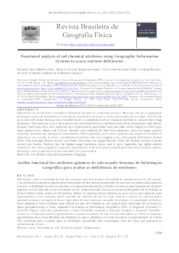Functional analysis of soil chemical attributes using Geographic Information Systems to assess nutrient deficiencies.
Functional analysis of soil chemical attributes using Geographic Information Systems to assess nutrient deficiencies.
Author(s): BARBOSA NETO, M. V.; ARAÚJO, M. do S. B. de; ARAUJO FILHO, J. C. de; SILVA, C. B. da; SAMPAIO, E. V. de S. B.
Summary: Information on soil fertility is essential to determine the need for correcting measures. However, the use of appropriate techniques to provide information on the specific potential of each soil in many agricultural areas is scarce. Soil fertility in an area with family farming was evaluated based on spatialization of soil chemical attributes to indicate their usage limitations. The study area was on the water basin of the Natuba River, in the Mata Centro Zone, Pernambuco state, Brazil. Samples were taken from soils under the most representative agricultural uses and under native vegetation following a slope gradient (top, middle and bottom). Samples were analyzed for their base saturation, cation exchange capacity, aluminum saturation and phosphorus concentration. These parameters were used to indicate their degree of limitation to agricultural use in order to create a georeferenced database and were mapped using a Geographic Information System (GIS). The cultivated Rhodic Acrisol and Eutric Gleisol had the highest fertility, while the Xanthic Acrisol, Chromic Acrisol and Xanthic Ferralsol had the highest usage limitations. Areas used to grow vegetables had higher nutrient availability than those cropped to sugarcane. Spatialization in the GIS system contributed to the overall fertility analysis, allowing a clear visualization of areas that need soil improvement.
Publication year: 2022
Types of publication: Journal article
Unit: Embrapa Soils
Observation
Some of Embrapa's publications are published as ePub files. To read them, use or download one of the following free software options to your computer or mobile device. Android: Google Play Books; IOS: iBooks; Windows and Linux: Calibre.
Access other publications
Access the Agricultural Research Database (BDPA) to consult Embrapa's full library collection and records.
Visit Embrapa Bookstore to purchase books and other publications sold by Embrapa.

